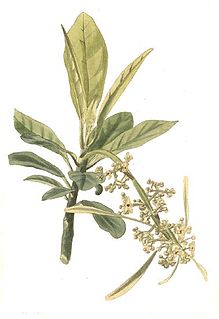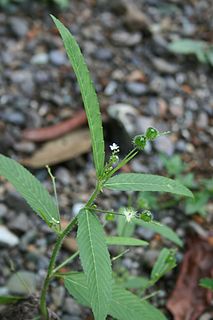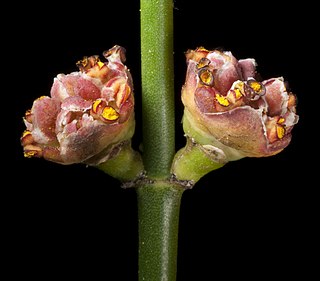
Phyllanthaceae is a family of flowering plants in the eudicot order Malpighiales. It is most closely related to the family Picrodendraceae.

Omphalea is a plant genus of the family Euphorbiaceae first described as a genus in 1759. It is native to tropical parts of the Americas, the West Indies, Asia, Australia, and Africa.
Dysopsis is a genus of plants in the family Euphorbiaceae, first described in 1858. It is the sole genus in subtribe Dysopsidinae. The genus is native to Costa Rica, Panama, South America, and the Juan Fernández Islands.
- Dysopsis glechomoides(A.Rich.) Müll.Arg. - Chile, S Argentina
- Dysopsis hirsuta(Müll.Arg.) Skottsb. - Juan Fernández Islands
- Dysopsis paucidentata(Müll.Arg.) Lozano & J.Murillo - Costa Rica, Panama, Colombia, Venezuela, Ecuador, Peru, Bolivia
Cleidion is a plant genus of the family Euphorbiaceae, first described in 1826. It is found in tropical and subtropical regions in Asia, Africa, Australia, Latin America, and various islands of the Pacific and Indian Oceans.
Crotonogynopsis is a plant genus of the family Euphorbiaceae first described as a genus in 1899. It is native to tropical Africa.
- Crotonogynopsis akeassiiJ.Léonard - Ivory Coast, Ghana
- Crotonogynopsis usambaricaPax - Cameroon, Zaïre, Uganda, Tanzania, Mozambique
Lasiocroton is a plant genus of the family Euphorbiaceae first described as a genus in 1859. The genus is endemic to the West Indies. It is a member of the Leucocroton alliance, which also includes Leucocroton and Garciadelia. Species in this alliance are dioecious.
- Lasiocroton bahamensisPax & K.Hoffm. - Bahamas, Cuba, Haiti
- Lasiocroton fawcettiiUrb. - Jamaica
- Lasiocroton gracilisBritton & P.Wilson - SE Cuba
- Lasiocroton gutierreziiJestrow - Cuba
- Lasiocroton harrisiiBritton - Jamaica
- Lasiocroton macrophyllus(Sw.) Griseb. - Jamaica
- Lasiocroton microphyllus(A.Rich.) Jestrow - Cuba
- moved to other genera (Bernardia Croton Leucocroton)
- Lasiocroton cordifoliusBritton & P.Wilson - Leucocroton cordifolius (Britton & P.Wilson) Alain
- Lasiocroton prunifoliusGriseb. - Croton punctatusJacq.
- Lasiocroton subpeltatusUrb. - Leucocroton subpeltatus(Urb.) Alain
- Lasiocroton trelawniensisC.D.Adams - Bernardia trelawniensis(C.D.Adams) Jestrow & Proctor

Alchornea is a plant genus of the family Euphorbiaceae first described as a genus in 1788. It is widespread in tropical and subtropical regions of Africa, S Asia, Australia, Latin America, and various oceanic islands. Molecular phylogenetic analyses suggest that Bocquillonia from New Caledonia is nested in Alchornea.
Orfilea is a plant genus of the family Euphorbiaceae first described as a genus in 1858. It is native to Madagascar and other islands in the Indian Ocean.
- Orfilea ankafinensis(Baill.) Radcl.-Sm. & Govaerts - W Madagascar
- Orfilea coriaceaBaill. - Comoros, Madagascar
- Orfilea multispicata(Baill.) G.L.Webster - Madagascar
- Orfilea neraudiana(Baill.) G.L.Webster - Mauritius

Caperonia is a genus of plants of the family Euphorbiaceae first described as a genus in 1825. The genus is native to tropical and subtropical America and Africa.
Neoboutonia is a plant genus of the family Euphorbiaceae first described as a genus in 1864. It is the only genus in subtribe Neoboutoniinae, and native to tropical Africa.
- Neoboutonia macrocalyx Pax - Burundi, Cameroon, Rwanda, Zaire, Kenya, Tanzania, Uganda, Malawi, Zambia, Zimbabwe
- Neoboutonia manniiBenth. & Hook.f. - tropical Africa from Liberia to Mozambique
- Neoboutonia melleri(Müll.Arg.) Prain - tropical Africa from Nigeria to Mozambique

Excoecaria is a plant genus of the family Euphorbiaceae, formally described by Linnaeus in 1759. The genus is native to the Old World Tropics.

Baloghia is a genus of plants under the family Euphorbiaceae first described as a genus in 1833. It is native to Australia, New Caledonia, and Vanuatu. Cocconerion is a close relative.
Dodecastigma is a genus of plants under the family Euphorbiaceae first described as a genus in 1932. It is native to northern South America.
- Dodecastigma amazonicumDucke - Amazonas State in Brazil
- Dodecastigma integrifolium(Lanj.) Lanj. & Sandwith - French Guiana, Guyana, N Brazil
- Dodecastigma uleanum(Pax & K.Hoffm.) G.L.Webster - Amazonas, Amapá
Cocconerion is a genus of plants under the family Euphorbiaceae first described as a genus in 1873. The entire genus is endemic to New Caledonia and is related to Baloghia.
- Cocconerion balansaeBaill. - SE New Caledonia
- Cocconerion minusBaill. - New Caledonia, Loyalty Islands

Calycopeplus is a plant genus of the family Euphorbiaceae first described by Jules Émile Planchon as a genus in 1861. The entire genus is endemic to Australia. Its closest relative is Neoguillauminia from New Caledonia.

Neoguillauminia is a genus of plants in the family Euphorbiaceae first described as a genus in 1938. It contains only one known species, Neoguillauminia cleopatra, endemic to New Caledonia. Its closest relative is Calycopeplus from Australia.
Machaonia is a genus of flowering plants in the family Rubiaceae. It has about 32 species. All are indigenous to the neotropics. None has a unique common name. Some species have been called "alfilerillo", a Spanish name for the common and well-known genus Erodium. The type species for Machaonia is Machaonia acuminata.

Oxera is a genus of flowering plants in the family Lamiaceae native to Vanuatu and New Caledonia in the western Pacific.
Garciadelia is a plant genus of the family Euphorbiaceae first described as a genus in 2010. The entire genus is endemic to the Island of Hispaniola in the West Indies (divided between Haiti and the Dominican Republic. It is a member of the Leucocroton alliance, which also includes Leucocroton and Lasiocroton. Species in this alliance are dioecious.
- Garciadelia abbottiiJestrow & Jiménez Rodr. - Dominican Republic
- Garciadelia castilloaeJestrow & Jiménez Rodr. - Dominican Republic
- Garciadelia leprosa Jestrow & Jiménez Rodr. - Haiti, Dominican Republic
- Garciadelia mejiaeJestrow & Jiménez Rodr. - Dominican Republic
Myrtastrum is a genus of plants in the Myrtaceae first described as a genus in 1941. It contains only one known species, Myrtastrum rufopunctatum, endemic to New Caledonia. It is a phylogenetically isolated genus within the tribe Myrteae.









